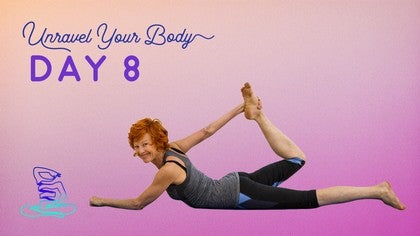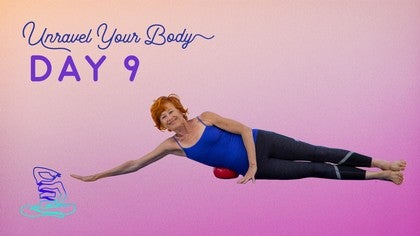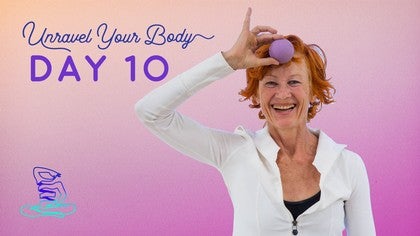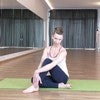Description
About This Video
Transcript
Read Full Transcript
Okay. Welcome today nine. Today we're going to be addressing the sideline of the body, which can have um, amazing shifts and changes when a person releases and opens it. And I'm warning you, it may be surprisingly tight when you start up. So to do the test and before we start just to see where you're at, if you stand up against the wall, I'm lining my heels, my buttocks, my shoulders, my head, and clasping the hands, my fingers against the wall. You may not be able to get all those body parts up against the wall.
You do your best because they're all indications of areas where you're holding tension and you're a little restricted, but you do the best you can. You stretch up as high as you can and keeping your knees straight so they're not bending and your elbows straight so you're not bending. You start bending over to one side and as you bend over, check or your hands touching your wall as your upper rib cage. In this case, mine is my left rib, cage and shoulder touching the wall on my hips, touching the wall, my buttocks and my feet. And how far can you go and then come back. So quite intense for some people at the beginning later on. No big deal, big lift and start going in the opposite direction.
Just checking out all those body parts touching and is there a difference between one side and the other and you can let your hips go in the opposite direction and then come back up so that just to see how much range of movement you have and then stepping a little bit away from the wall so your feet are facing straight forward rotational aspect of the body. See how far you can rotate around now fine to let even your ankles and your feet roll. We're looking to wring out every part of the body but it's very indicative of how much your ribcage and spine and sideline is actually unrestricted. So it allows free form movement. So just text, maybe you can only go this far. This is just to see where you're at before we start.
So we are going to be getting down on the floor. So you want to place the ball as close to the in your pelvic area. Pelvic, uh, on the pelvis may be into the waist and length and I'm lengthening my legs, lengthening my body, and then with the help of my hands, just lifting and lowering a few times and I can already feel that tractioning aspect along the whole side of the body's. I'm softening the tissue on the side of the body and then reaching out, pulling this arm as far as you can and draping over the ball to soften that tissue. Now I'm rolling. My feet down to the ball is up maybe closer to my waist, pulling as much as I can this whole sideline and draping down so I can feel the pressure of the ball a little bit into the rib cage and wastes and I'm going to roll slightly back and forth again, softening up the tissue, even softening up any resistant patterns in the bones, a little bit pressing up again, lowering down and going a little bit further.
Now I'm halfway up my ribs extending out, so it's like someone's grabbing my hands and grabbing my feet in the opposite direction. Again lengthening out and now I'm letting the ribs drape on the ball a little bit. Lifting up, lengthening out and relaxing, lengthening up and lengthening out. So who says you have to get shorter as you get older? Maybe you could talk and moving down a little bit further. Same almost up at my armpit again. Now when I'm lifting up, I'm feeling my rib cage being pulled away from my hips and then extending out, lifting up, extending out.
And at the same time being aware that as I lift up my ribcage dips or not my ribs, but my waist is actually dipping down. So we're restoring this more a fluid structure to the whole trunk area, into my arm pit area on the side, attempting to get as much of my ribs down and here just moving the hand back and forth once or twice, moving a little bit further down and now I'm really trying to sync the ribs down. I can literally feel my ribs opening up as I do this and expand. So the intercostal muscles are being stretched. And again, this is where it really can get into your trapezius muscles. And all the attachments going all the way up into the armpits and lengthen the arms out to the elbow and the arms going way out.
And now I'm rolling a little bit side to side into the muscular structure of the arm to release any tight resistive patterns in here. And don't be afraid of feeling that your shoulder is going up towards your ear. We want it now I'm almost at my elbow letting everything sink down and one more time moving the arm back and forth and then rolling off the ball and just for a minute, relaxing to the tissue soften and then coming up and moving on to the other side. So if you will look at me right now as I'm kneeling, you may notice that the right side looks considerably longer. You can actually be quite funny. And if I stand up, I think you'll notice, I feel like I'm leaning to the left cause it's so much more contracted and maybe even the length of my arms look different.
So just be ready for the fact that you look very strange in the middle of this. Now that I've made myself totally uneven. Let's go to the other side, starting out, legs along and I like to hook the ball. I'm hooking it right above my greater trow cantor actually and checking that the legs are long. Now for some people this is a little hard to balance and you may be more comfortable like that. That's totally fine. You want this sense of lots of lengths from your heel all the way to the top of your head.
And then from here I'm extending this arm out, tried to stretch my arm pit as much as I can, sinking down into the ball. So all of that deep elongation is starting to soften the tissue and allow it to relax and release a little bit. And just moving very, very slightly from right to left in the pelvis and then rolling down a little bit. So now I'm at the top of the pelvis into the waist area and start lifting up. So I'm lengthening, it's kind of like a half moon pose and reaching out and lengthening down, opening up and releasing any tight areas. And there are definitely a few of them lifting up and lengthening out.
I like to creep my fingers out as far as I can. Trying to find how much further I can go and at the same time softening into the ball, rolling a little bit further forward and rolling back to constantly soften the tissue around the waist area. Now coming up a little bit, I'm rolling further down so I'm kind of at the base of the ribs and releasing down some kind of middle of the rib cage. Rolling a little forward, a little backwards, a little forwards, a little backwards and then again lifting up. Interestingly enough, as I lift up, I can feel the ball roll down as I stretch out, it rolls the ribs so there's a little bit of the seesaw movement as my body has a moving relationship with a ball and now moving up to the middle of the rib cage.
Starting to let my rib cage drape over the ball.
Moving down a little bit further, now I'm at the top of the rib cage right before my arm pit. This area can be very congested for people and again, I'm rolling a little forward, a little bit back and at the same time taking a lot of advantage of pulling this arm out as much as I possibly can to open up all of the connection of the arms into the armpit area. That can be very tight for people. Again, lifting up a little bit, lowering down, lifting up, lowering down, and now moving all the way down. A lot of stretch starting to come into the armpit area, rolling the arm a little bit forward and back as you go through the arm tissue, you may have a clunk, clunk, clunk feeling because you're working through the triceps and possibly um, the, the mass of the muscle in relation to the bone. This is a good thing you wanted to happen and working the arm back and forth, try to get the arm behind the head. This angle for some of you may be very challenging.
You may not be able to get it at the beginning, even if the hand is coming forward. This is all good because it's starting to ask all of the tissue to get longer and release its hold on the muscle all the way and then come off the ball. Just take a moment to let everything relax and then coming up to sitting position. Let's see if I'm more even, I feel more even now, I hope I look more even and let's stand up and see if I'm more centered. How are you doing?
So we visiting the side now actually dealing with the arms more specifically. We'll work with the smaller ball and start out with the arm right close to the elbow and down and here I sometimes keep my knees bent, so if your arm is straight you want to try and sink down into the tissue and just bend it back and forth a few times and then roll the arm side to side. This is called Cross fibering across the tissue and you may have little pockets of pain or tension. Also you can open and close the hand and rotate the wrist moving up a little bit. Same thing back and forth, cross fibering all the time. I'm trying to keep my rib cage down, not up, down. So do you say that lengthens out the whole sideline?
Open and closed the wrist, the fist, roll it and move further down. If you visit areas of movement that are specifically painful for you or restricted, those are the gold mines. You want to spend time there. They will change everything about your structure. It's like your body's communicating during say right here, right here as what the nod is.
That's keeping me from doing full range of movement as far as my ability goes and then coming up and we'll do the same thing on the other side. So turning around, starting out with the ball near the elbow, lengthening the ribs as much as I can down into the floors. I'm using it like a rack literally and extending and bending the arm, cross fibering going back and forth, forward and backwards, trying to press into the ball and keep my body long opening, closing the wrist or the hand and circling around so that we actually putting pressure into one part of the muscle and then asking full range of movement from other parts of actually releases all the tissue and restores the freedom and disassociate one muscle group from the other. So here we go back and forth. All right, there is wonderful for me. I can feel on my tricep is being forced to get longer rather than shorter in order to release the movement there it comes back and forth and hand movement of all sorts.
You can rotate the hand around, you can open and close the fingers. Moving even further down. I'm right close up to my arm pit. Again, trying to keep my rib cage down as close to the floor as I can. Reach the arm back and forth. Cross fibering right in there.
There's a lot of areas where the muscles are connecting right close into the armpits and can be quite tight, rotating and sinking into the whole rib sidelight area. Oh, that feels wonderful because it really ironically opens up my rib cage and frees up my ability to breathe better because all of this has just been released also, which should help you feel your shoulder girdle better. Next ball routine addresses a quad radial to lumborum or the QL very directly. Um, often when you have a person who has one hip higher than the other, that can be the reason that the QL is pulling. Not always, but it can be a major factor in this. So this can have profound release effects on the pelvis.
If you're more flexible, use a bigger ball. If you're less flexible, use a smaller ball. So if it's very tight for you, just choose the right ball for you. I will demonstrate on the bigger ball. I'm kind of in the middle in actuality. So if you were to bend into the side, you and you have your hands digging in way, my thumb is you can feel a tightening and that is your QL.
So it's right on the side beyond the erector spinae, the two big muscles, she does think back of your waist. You'll be okay actually. So I'm placing the ball right there and then I'm starting to drape my bottom down so I'm trying to release and let go. Let the bottom fall. It's like sticking your bottom out but see if you can get into the sensation. What's a weight of my pelvis dropping down and then very slowly let the rest of your body fall down around the two you're draping around this ball and creating a curve into that area of your back. And if this is intense, which you probably will be first time, you want to really focus on breathing and letting go of any tension and letting that muscle realize it doesn't have to work so hard all the time and actually as it lets go, the release is phenomenal in the comfort and diminish pain or tightness in the back. Then from there I'm letting the knees drop a little bit to the right and I'm rolling very slowly letting the natural curves of the spine come in, rolling a little bit into the ball, just letting this whole area release and relax.
So very, very important to keep the spinal column a flexible and mobile and it's all good. Letting the back relaxes way you my back. Just let go. So doing the other side. So on the left side I'll demonstrate with the orange ball just so you have a different perspective and what it's like again, slightly off halfway between the back and the waist area, placing it just above the pelvis into the waist and draping down. So I think on this side you can see better. There's this natural curve you really want to sink into. The bigger the ball, the more the back can actually relax around it. The tighter you are, the smaller you want it to be. So you can start to relax.
Once I have that, I'm letting my pelvis really curve. I can feel the muscles relax and very slowly drop my knees and breathe into it. So the ball is almost on the side, but not really. It's still on the back. My pelvis is still curved and rounding and sinking into the ball.
I'm allowing all of that tissue to soften depending upon how intense it is for you. You want to spend time here breathing, relaxing, and you will suddenly feel your back. Let go and let go and let go and that's all good. You want all of that tension to leave. Ah, that feels wonderful. And coming back up. Okay, so now it's time to, we test and see what happened with the sidelines. Again, standing up against the wall, lifting the arms up, bought my arms, flew right up. Now, nice stretch.
And how far can you go to one side and how much can you basically bend sideways, which means your body is nicely releasing. The ribs are opening. The waist is much more relaxed, much more mobile. Hopefully you feel like a willow before you may be. You felt like an oak. We like willow, we feelings and then I know I'm more opened up quite a bit standing. How much, how easy or how hard it is to rotate.
I definitely can rotate further than I did before I started all this side still is a little stiff, but that's okay. So I hope you find more movement in your body. Enjoy it.
Unravel Your Body Challenge: with Niedra Gabriel
Comments
Most likely we should have thought of that before now to make a clean edit for you and represent Niedra Gabriel well. I really appreciate the feedback and will see what I can do!
You need to be a subscriber to post a comment.
Please Log In or Create an Account to start your free trial.





















